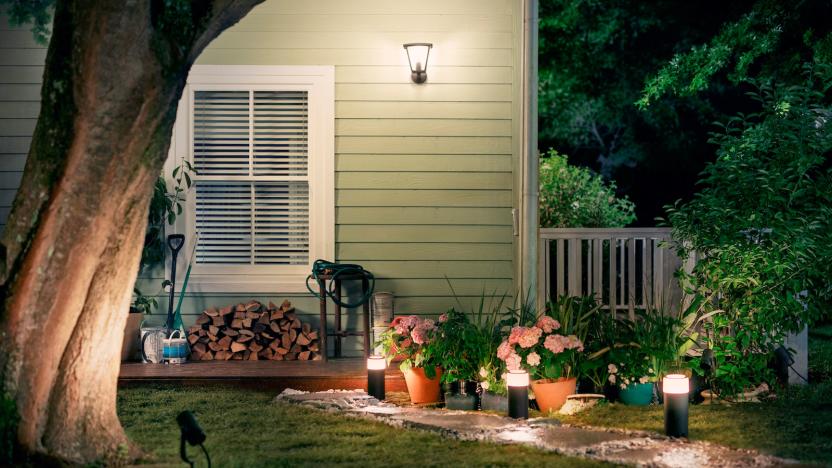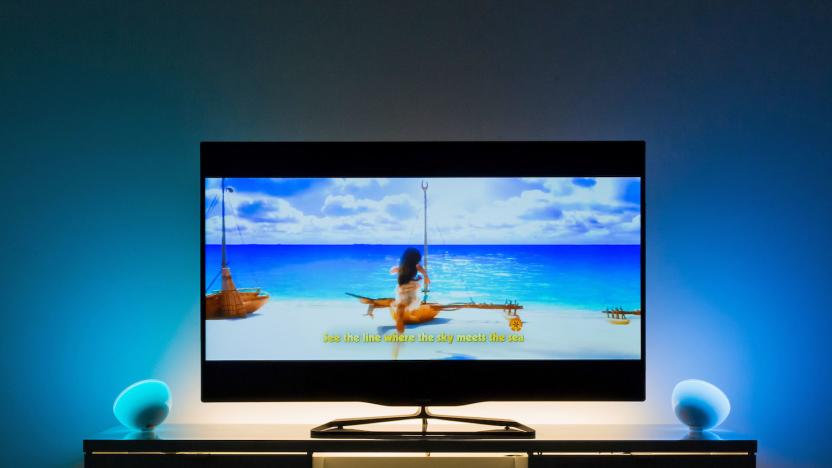smartlighting
Latest

Ring devices will soon work with Lutron's smart lighting systems
You can set your lights to turn on for a while when Ring devices detect movement.

Philips introduces its first outdoor Hue lights (updated)
Philips Hue is a popular smart home lighting system, so it was only a matter of time before the company extended to the outdoors. Today, Philips announced its new outdoor range, which extends the light bulb system's smart features from within the home to its exterior.

Netgear's smart security light alerts you of unwanted guests
Netgear is taking another stride into smart home security under its Arlo banner. The company has already released a bunch of comprehensive surveillance cameras, and its latest piece of connected hardware is a wireless, outdoor security light. Like smart bulbs before it, the light hooks up to a mobile app to let you customize its color and brightness. But, you probably won't be using it to set the mood for a dinner party. Instead, it will ping you when it detects motion, and automatically turn on in the process. Thankfully, you'll be able to tinker with its sensors on your smartphone, so it doesn't blink every time a pet runs by.

Philips' Hue lights will soon sync with movies, games and music
In the five years since Philips introduced its Hue range, it's been joined by many other companies offering their own version of its smart lighting. To stay ahead of the competition, the electronics giant has focused on adding platform partners, while introducing new bulbs that appeal to every kind of homeowner. To celebrate its fifth birthday, Philips confirmed today that it will further extend the compatibility of its kit and allow owners to synchronize their lights with movies, video games and music.

IKEA launches its own low-cost smart lighting range
For many people, their first foray into the world of home automation begins with lighting. There's a good reason for this: smart bulbs easily fit into existing furnishings and can be operated using just a smartphone, which (mostly) everybody now owns. Philips, with its Hue range, is perhaps the most well known smart bulb maker, but that could soon change thanks to a new entrant: IKEA. That's right, the world's biggest furniture chain is today debuting its own smart lighting range in the UK. As you'd expect, the prices are a lot easier on the wallet.

Philips Hue motion sensor turns lights on for you
So you have your home all decked out with some sweet smart lights that you can control with your phone. Big deal. True convenience is when your lights turn on exactly when you need them to, without you even lifting a finger. And Philips' new motion sensor can help you achieve that. The $40 device will be available in October, and after my brief preview of the Philips Hue motion sensor, I can't wait till I can get one.

LG's first smart light bulb flashes when you get a phone call
LG isn't about to let household heavyweights like Philips corner the connected lighting space -- it just unveiled the Smart Lamp, its first take on the concept. The 10W LED bulb gives Android and iOS users a familiar level of control over their illumination, including a light-based alarm clock and a security mode that pretends you're at home. There are a couple of noteworthy tricks in this initial offering, however. The light connects through both Bluetooth and WiFi, letting it pull the sync-based stunts we've seen in a few other bulbs: it can flash when you get a phone call, or (with Android) pulse to the beat of the music. The Smart Lamp is more expensive than ordinary LEDs at 35,000 won ($32) in LG's native Korea, but it could be a good deal if you don't need the many-colored lighting of Hue and similar systems. Unfortunately, there's no word on whether or not it's coming to the US.

Philips' smart lighting tells you where to go in the grocery store
Ever spent ages wandering the grocery store while looking for a hard-to-find ingredient? If Philips brings its new connected retail lighting to your local supermarket, you may always know where to go. The technology uses light-based communication to create a positioning grid for your smartphone, telling you just what route you'll need to take to get everything for that recipe. Naturally, shopkeepers can also use the system for location-based discounts and suggestions; if you're looking for dessert ideas, the lights can point you to the pastry section. Philips is already testing its smart illumination with a handful of stores, so it might not be long before you're shopping with extreme efficiency.

Belkin announces a remote-controllable slow cooker, smart LED light bulbs
Last year, if you recall, Belkin announced a partnership with Jarden (the company behind brands like Mr. Coffee, Sunbeam and Crock-Pot), promising we'd eventually see kitchen appliances with Belkin's WeMo home automation control built in. Now, at CES 2014, Belkin finally has a real product to show for it: The company just announced the Crock-Pot WeMo Slow Cooker (how's that for a name?). Being a smart product and all, you can use the WeMo app for iOS or Android to remotely turn it on or off, adjust the temperature or change the time settings. You can also receive reminders so that you don't let it sit too long. Look for it to ship this spring for $100, with an air purifier, space heater and coffee maker to follow later this year. Additionally, Belkin introduced the WeMo Smart LED Bulb, a dimmable light that can be controlled remotely using the same WeMo app you'd use to control the slow cooker. In particular, you can control the bulbs individually or in groups, and also set them to dim as you sleep and wake up. Once it goes on sale this spring, you'll need to shell out $130 for the starter kit, which includes two bulbs (60W-equivalent) and a bridge that plugs into an outlet. Thereafter, the lights cost $40 apiece and are said to last up to 23 years. Also, the bridge can connect to up to 50 bulbs, so odds are you'll never have to buy another. Last up, there's the WeMo Maker kit, which lets modders manage anything with a simple DC switch -- gates, garage doors, blinds, AC units, you name it. That will also arrive this spring, but no word on price.

Insert Coin: Luminode dimmer switch runs on a mesh network, learns to light up our lives (video)
In Insert Coin, we look at an exciting new tech project that requires funding before it can hit production. If you'd like to pitch a project, please send us a tip with "Insert Coin" as the subject line. Just a simple light switch, you say? Look closer. Think Automatic's Luminode dimmer switch hides both a processor and a mesh network connection that lets every switch in the home coordinate with each other. A multi-tap system makes it possible to link multiple lights together without extra wiring or complex programming, but that's just the start: it's possible to create "scenes" of predefined lighting levels and, with a USB adapter, hook up to home automation systems (including Think Automatic's own) that can learn usage habits, track energy consumption or simply let us control the array with our smartphones. The platform uses raw XML to communicate and already talks to GE, Insteon and Stargate hardware -- all without requiring a huge grid of buttons or displays. Development of the Luminode is very nearly done after six-plus years of work in Seattle. The hardware is fundamentally ready and just needs the Kickstarter project to finish its FCC and UL testing along with the obligatory mass production. The hope is to start delivering switches in January as well as integrate more closely with non-lighting elements in the future. Pledge levels are dictated almost exclusively by volume: $130 is what it takes to get a basic two-switch kit, $260 will add the USB adapter along with an extra switch, and successive levels scale all the way up to a 50-switch, $3,000 kit for large homes. Think Automatic has a relatively low $35,000 threshold to meet its Kickstarter funding, but it only has 13 days left to go. If you like the idea of advanced lighting that doesn't require an advanced appreciation of the user manual to understand, now's a good time to click the source link and make it happen.

GreenChip lighting lets you flip the switch remotely, thumbs nose at IPv4 depletion
Despite the looming IPv4 apocalypse, a new lighting system coming out of NXP Semiconductors promises an "IP address for every light bulb." The GreenChip "smart lighting solution" incorporates NXP chipsets into both LED and compact fluorescents to enable dimming, extended lifespans, quick start times, and IP connectivity -- via IPv4 or IPv6. Proprietary network software allows users to control their bulbs from smartphones, PCs, and other devices, enabling them to fiddle with mood lighting -- including adjusting color -- via a specific IP address. So at least when IPv4 doomsday finally descends someone will have their lighting just right. Video and PR after the break.

MIT developing smart adaptive LED lighting system to reduce energy use by up to 90 percent
It's very well that manufacturers are constantly pushing for more efficient LEDs, but we can do better than that: what if we could have an LED lighting system that pumps out just the right amount of juice to suit our changing environment? That's exactly what the tree huggers at MIT are working on right now. Said adaptive system relies on a small box that not only acts as a position tracker, calibrator and sensor for the dimmable overhead LED fixtures, but also lets the user set the desired tone and light intensity for the room. In other words: no matter how sunny or cloudy it is outside, you'll still be comfortably basking in the same steady shine in your room, while also saving up to 90 percent of energy. Our guess is that Philips -- the project's sponsor -- will eventually release a product based on this technology, but for now, you can see the system in action after the break (from 1:07).








